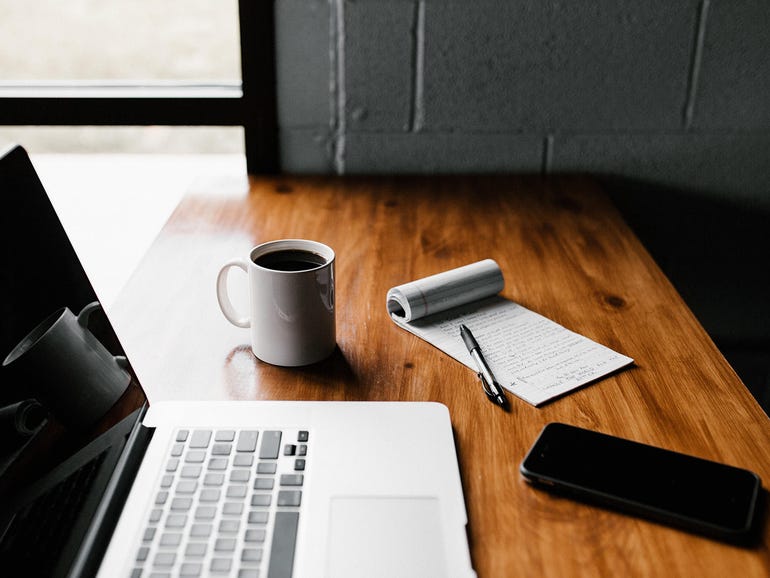
My top productivity tools and tricks for managing my daily workflow (2022 edition) | ZDNet
This article was originally published in October 2014. It has been updated every year or so since then to reflect new tools and workflows.
Remember the old productivity and office suites we all used to use? I don’t know about you, but my mix of productivity tools has certainly changed over the years. What I use today is vastly different from my daily productivity “suite” of years past.
Also: Office 365 vs Google Workspace: Which productivity suite is best
Before I take you through both the tools and my “process,” let me point out that this stuff is different for everyone. My work these days consists far more of educating and communicating, and far less time spent living in spreadsheets than back in the days when I ran startups.
Today, I coordinate with teams, rather than manage them. I have students rather than employees. I research projects rather than launch products. My daily productivity flow reflects the changes in career as I’ve evolved from founder to advisor, manager to professor, and publisher to columnist.
I use a tremendous number of tools for my projects, and they often change from project to project. But what I’m going to discuss here are the tools I use on a daily basis to manage my “flow”.
What do I mean by my flow?
I divide my work day into two main chunks of time: Communications and knowledge gathering time, and project time. Every day has pretty much the same communications and knowledge gathering activities, which follows a relatively consistent pattern that has proven to be highly productive for me. These are the daily productivity activities I’ve been talking about.
In my case, morning to mid-afternoon is that daily productivity time. That’s when I connect with and follow-up with all my constituents, students, editors, producers, etc., when I do my daily reading to keep up with both news and new technology, and when I manage my schedule, schedule my tasks, make calls, and write and respond to email.
Also: Can a smart office make your team more productive too?
That whole process is my flow. Over my many various iterations, I’ve managed to optimize this process so I’m able to get a tremendous amount done in a relatively short amount of time.
The other half of my day is project time. This is when I work on everything from academic papers to the presentations, white papers, and webcasts I do for ZDNet to developing code to most of the projects I write about for DIY-IT. I tend to work on projects in the late afternoon and the late evening, with a break in the early evening for family time and lunch or dinner.
Changes due to the pandemic
The last time I updated this guide was in early 2019. Obviously, a few things have happened since then. In terms of my daily productivity, I go out a lot less than I used to. Back then, I was often running from place to place and had to build up an everyday carry (EDC) that could allow me to dive into any project or work with any team no matter where I was. I had EDC kits for a coffee shop programming run and EDC kits for week long conference work. I even built an EDC for emergency evacuation of an indeterminate time.
Also: What’s inside Gewirtz’s home office? 20 years of refinement and evolution
Now, mostly I’m home. If I’m out, it’s a dedicated out-and-back with a specific purpose. There is no meandering, browsing, or schmoozing. Yes, I know other people may feel comfortable going back to the pre-pandemic normal, but I have reasons for playing it a bit more safe than most might.
In any case, what that means is that instead of my escalating ranking of phones, tablets, Chromebooks and laptops, I just carry my iPhone 12 Pro Max. It will keep me up to speed until I get back home and can pick up where I left off.
Tools for my daily flow
Now that you understand how my working environment has changed and how I structure my work day, let’s discuss the tools I use in my daily flow. It all starts with Gmail…
First morning Gmail
It’s been quite a while since
I made the switch from Outlook to Gmail
, and I have to tell you, my productivity has improved tremendously, and after more than half a decade of use, I don’t regret the move one bit. Having the exact same email interface on all my machines, with tight integration into my iPhone, iPad, and computers, has made all the difference.
I no longer have thousands of unruly items filling my inbox. In fact, that’s a big part of what this daily productivity process is all about.
Also: Help! I have 100,000 unread messages in my Gmail inbox. How do I get to Inbox Zero?
My day starts with my alarm going off. From under the covers, I usually reach over to my phone, painfully crack one eye open, tap the Gmail app, and scan to see if there’s anything on fire.
Actually, scratch that. I no longer take my iPhone to bed with me. Instead, I wear my Apple Watch. When I wake up, I can still glance at my notifications, but by leaving the tiny computers outside of the bedroom, I’m not tempted to check on work, read my mail, or play Wordle when I should be sleeping.

The boy
The way I have Gmail set up, only the most important messages show up on my watch. Same with Slack notifications. Basically, unless there’s something urgent from one of my editors, I can start my day in peace. If there’s nothing urgent, I hit the snooze button. After repeating this ritual two or three times, I get up, do my morning necessaries, and zombie-walk to the coffee maker.
Once I have coffee in hand, I navigate
the puppy’s
tower defense strategy for the morning, trying not to get my toes bit, spill my coffee, or step on one of his well-chewed stuffed animal friends. Eventually, I reach the couch, flip on my couch-side monitor, and once again check my email.
At this point, I tend to take note of what’s in my inbox, but I neither process it, nor respond to it. I want to let the coffee take hold.
I also take a quick look at my calendar and my to-do list to make sure I know what’s on deck for the day.
Daily must-reads with Pocket
Next up, I hit my daily most-reads. Of course, this starts with ZDNet, then usually Drudge and Techmeme. I do a quick headline scan and anything that seems worth reading, I right-click and save to Pocket.
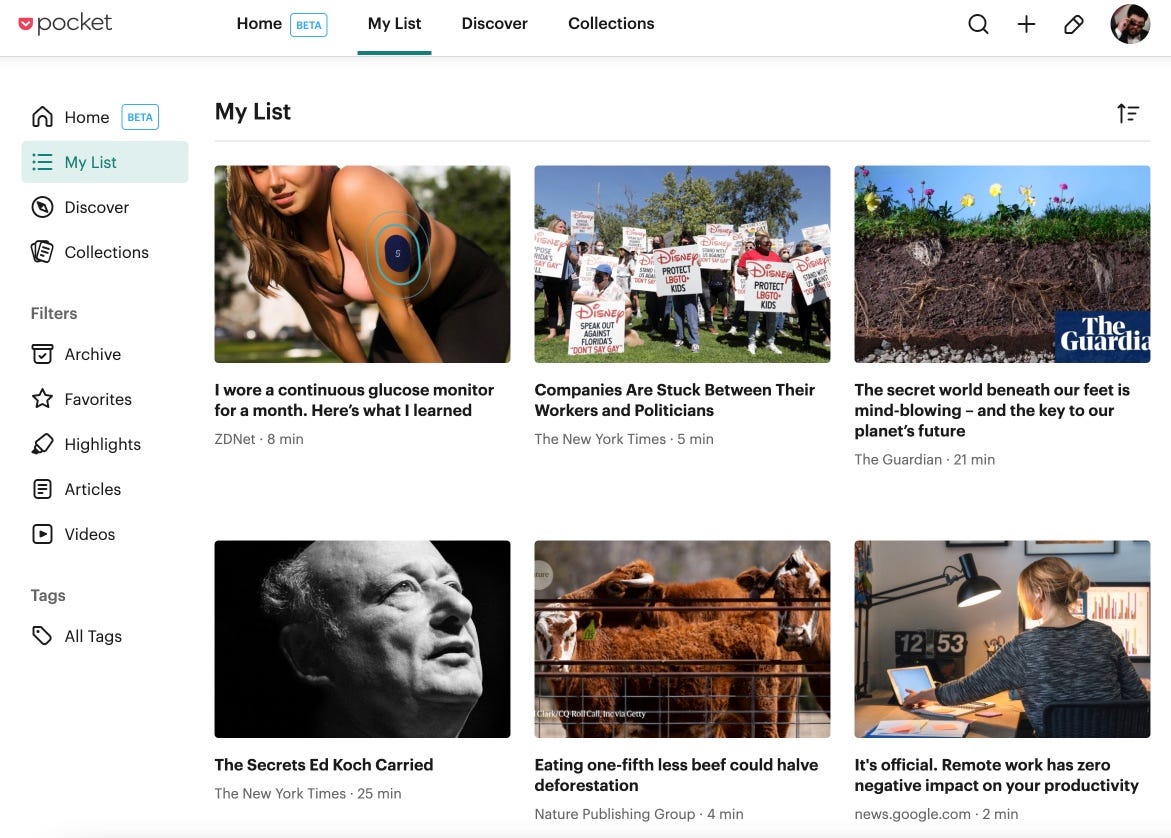
Some of my reads for later today.
Before I used Pocket, I used to open all the interesting headlines as new tabs. My browser was often overwhelmed with browser tabs, sometimes to the point of crashing. If I switched computers, I had to try to figure out what tabs I had open, and otherwise somehow coordinate 10-50 open tabs. It was a mess.
Now, I just save everything into Pocket, for later review. I actually do this in two phases. I use ZDNet, Drudge, and Techmeme as a quick way to find out what the big news of the day is. Later in the morning, I’ll open up Feedly, and tackle as many sites as I feel I have time for, from my big list of feeds. Or, I might dig into a story that’s interesting and trending, and look for more content, which I’ll also save into Pocket.
The nice part about this is I can easily do this while drinking coffee. I can get a feel for the day from the headlines, but I don’t need to have all my brain cells online quite so early. Then I go and make my oatmeal. I now eat oatmeal for breakfast every day. Why didn’t I do this when I was younger. It’s so good for you.
By this point, I’m somewhere between 30 and 60 minutes into my day, I’ve had one or two cups of coffee, and I have a pretty solid feel for both what’s going on in my own various domains as well as what’s going on in the rest of the world. It’s a very good, very quick way to come up to speed while waking up.
Depending on the importance and urgency of the messages in my Gmail inbox, I’ll either go straight into my morning email cycle or begin my morning reading. I prefer to do morning reading before email, so I’ll discuss that next.
The Pocket-read-post-archive cycle
I read. A lot. I need to keep up to date on a tremendous amount of information, both breaking news related and deep technical or academic information. As a result, a good percentage of my morning is spent reading. I also watch a lot of YouTube videos. I’m almost always learning about new stuff, and many YouTube videos provide great introductions to both how those things work and what they do. Without YouTube, I never would have gotten my CNC up and running and done my first successful build.
Because I’ve already selected the articles from my top sources, I can open up Pocket and start reading. I like this a lot, because I now have all my content in one location.
What’s particularly nice about Pocket is that it runs on not only my couch-side web browser and on Chrome, but there are versions of Pocket for iOS and Android. As a result, I can read articles anywhere — even in the necessarium or when I’m out and about.
Part of my morning flow is posting to the social networks. Unfortunately, this has changed. It used to be that whenever I found an article that was interesting in my Pocket collection, I tapped the Share icon in Pocket and then selected Buffer. Buffer then took the article, scheduled it, and posted it to Twitter, Facebook, and LinkedIn. Two clicks and I used to be able shared something interesting.
But Facebook broke that. Facebook no longer allows tools like Buffer and Hootsuite to to post to personal Facebook pages. I’ve spent years building up my personal Facebook page following and don’t want to start a corporate page (or orphan all my followers), so when Facebook broke auto-posting, it hurt. Now, I hand post to Twitter and then do it again on Facebook. LinkedIn gets a lot less attention, and, frankly, I post less frequently.
Another aspect of my morning reading that’s changed is I no longer save articles to Evernote. I used to save off articles that would serve me for either projects I’m working on or general research resources. While I use Evernote to write articles, I no longer use Evernote as my hub of everything. Pocket handles archived articles just fine. And Notion (more on that later) handles notes.
Rinse, wash, repeat.
I’m relatively holistic about my morning reading process. I do it until I’m bored or hungry, or feel like switching gears and moving on to managing my email and schedule.
The key point to all of this is that ever since I moved to this Pocket-read-post-archive cycle for my daily reading, my productivity and flexibility has gone up tremendously. I’m getting more done, and the quality of the process is far more pleasant. I’m no longer tied to my desktop browser, because all of these tools work on all my devices.
Connecting and scheduling
Assuming there’s nothing on fire that I’ve had to handle first thing, at some point during the morning, I’ll switch from reading to communicating. I’ll switch out of Pocket and into Gmail and work my way through my email.
Gmail does a great job of filtering out spam, but I’ll go through the Updates and Promotions tabs and delete or mark-as-spam anything that’s not necessary. This is usually a pretty fast cleanup.
Sometimes, there’s something in my Updates section that indicates there’s an action item. For example, if one of my websites has pushed out a security warning, depending on the severity I’ll either go right to work fixing the problem or sending the email to Todoist as a to-do item.
This is where the integration of Todoist and Gmail is so nice. All I need to do is tap the Todoist icon, and I can turn the email message into a to-do item, complete with a link back to the original email message. Once I’ve scheduled it as a to-do item (either for that day or a later date), I can then archive the message and it’s out of my inbox.
Also: Microsoft To Do vs Google Tasks: The best list manager app for you
I use the same process for the rest of my email. If I can reply immediately to a query from someone mailing me, I do. If not (for example, if it will require additional research or it’s really an action item disguised as an email message), I’ll send it over to Todoist as a to-do item and clear it out of my inbox.
I do the same with calendar-related items. For example, I’m on the Information Systems and Management Certificate Advisory Board at the UC Berkeley extension, and when I get an email that there’s a scheduled meeting, I can right-click on the date right in the middle of the email message and schedule it to the calendar. Once again, the original email is available as a link, so I can remove it from my inbox and archive it.
In this way, I can power through my inbox, responding, assigning to to-do items, or to calendar. Within a very short time, I have my inbox cleared.
Now, to be fair, I have a slight email fetish, so I do check back in to my inbox, once or twice (or 20 or 30 times) a day. But now that my inbox is generally clean and empty, that practice doesn’t have much to grab onto, and it’s only a waste of a second or two.
In fact, now that I have email notifications integrated into my watch, I’m finding I’m actually breaking myself of the habit, because unless I hear the notification tone, I don’t have any important emails coming in. I have actually gone a few hours without checking my email inbox, which is something of a record for me.
Managing my daily teaching opportunities
As it turns out, supporting users is a lot like teaching online students.
Some years ago, I adopted a bunch of WordPress plugins as a side-project that helps me keep my coding skills sharp. One of the (unexpected) side-effects of that is that I now have users to support. Yep, even free plugins require some amount of support time.
The way I manage this is I’ve added a support ticketing system to my lab notes website. I use a cloud service called Help Scout. Users post their questions and I get an email notification. All the details for each users’ situation is kept in one thread on the site, so when I go back to the conversation days or weeks later, I can see what previously transpired, all in one place.
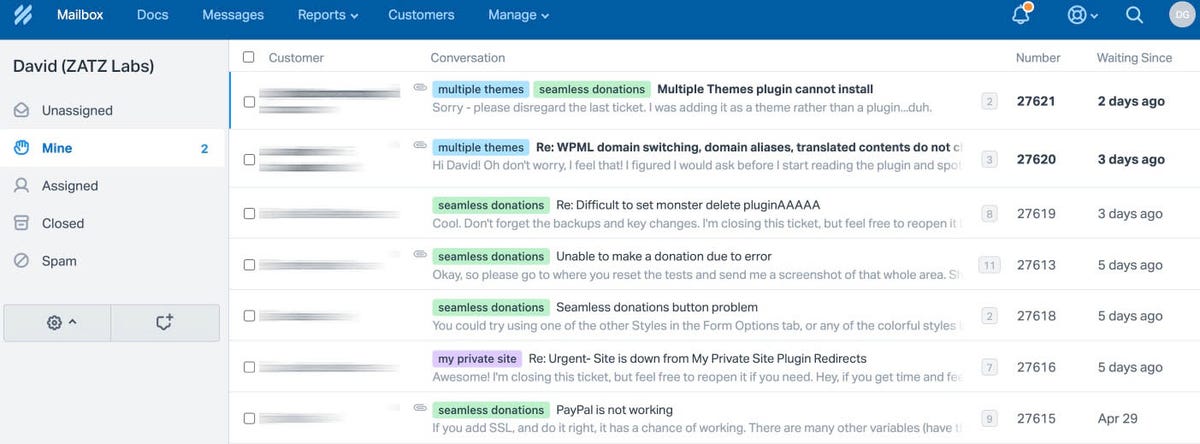
Help Scout also has great team features, but I’m a programming army of one.
I just think of those users like more of my students. If any questions show up in my inbox, I go into the ticketing system and answer questions. I’m not assigning users letter grades, but otherwise the process is pretty much the same.
By the way, this is also a great way to think about users, which I initially was a bit unhappy about adding to my daily workload. But the reframe is this: I’m an educator and these are more people in need of assistance while they’re learning to use these plugins. So, rather than thinking about providing user support as an added workload, I think of the users as more of my students and their questions as simply more teaching opportunities. It’s also a great way to keep up on what people are doing out there, and gives me a much more “on the street” dialog with users, which is invaluable as a tech journalist.
Here’s another little trick I use: I get a lot of feature requests (which I call “cool feature ideas”) from the plugin users. The go into the bug tracking system I manage in Notion.
To-doing my to-do list
By this point, I’m usually most of the way through the morning. My email has been processed and actions have been moved to my to-do list and schedule items to my calendar. I’ve done a considerable amount of reading, and I’m up to speed on the various issues I’m responsible for following. I’ve graded students and supported users (and added any bugs or key follow-up items to my to-do list).
Now, it’s time to tackle the to-do items. Like Pocket and Gmail, Todoist runs on my phone, my tablets, and on my desktop in a browser window. It even runs on my Apple Watch. So I can organize and manage my to-do items from anywhere.
The very first thing I do is go down the list and move items around. Some items are no longer a today priority, while some have increased in priority. I have some repeating tasks (like grading students for each of my sections) that pop up when they need to.
Before I go on to the rest of my day, which is doing my to-do tasks and slowly migrating into project time, I’ll tell you my newest secret weapon for managing to-do items: Notion. I used to use Trello to do this, but hit a couple of walls. Notion, which is a bit new and a bit weird, has a whole pile of possibilities.
Also: Notion app review: Why (and how) I rely on this powerful productivity tool
Notion solves a classic to-do list problem: Too many items on the to-do lists. We all suffer from this practice, where anything that might have to be done, even someday items and “I’ll get to it when I can” items, future project ideas, and all the rest all wind up on the to-do list as low-priority items that fill the list to the brim.
Some days are spent merely taking all those items that were previously scheduled for the, say, 15th of next month, and moving them to the following month once again.
I gave this problem a lot of thought and realized there are items I need to do, that are actionable in the near term, and items that just need to be on a list somewhere, that have no specific priority.
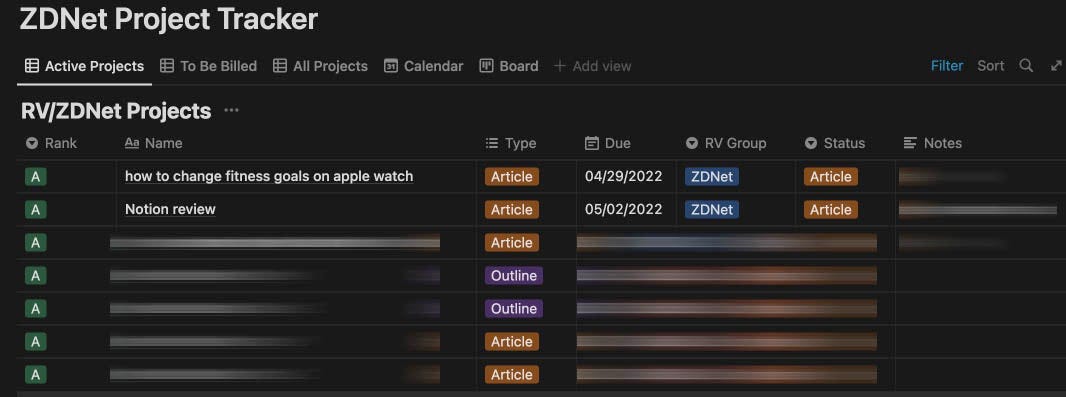
Managing projects in Notion
Notion is a combination whiteboard, list manager, project manager, app engine, and database. It’s actually quite odd and quite wonderful. It takes a while to get your arms around all it can do, but once you do, it’s incredibly helpful. Unfortunately, it’s got a silly name, a relatively uninspiring icon and marketing site, so I worry about its survivability. That said, it does have some serious funding behind it, so I’m hoping for the best.
You can create boards of certain categories, and inside those boards, you can make lists. Each list item is a card on a board, and you can write notes and interact with other members of a team on the back of each card. It sounds complex, but it’s amazingly intuitive.
Notion is also available on Android and iOS as well as web platforms, so once again, I can work on my work from anywhere.
I’ve set up a bunch of Notion pages and all the items that “should be on the list” but aren’t actionable this week or next go onto a Notion. I regularly dig into those pages, particularly when I’m working on a corresponding project, and pull items from the page and assign them to Todoist — but only if I intend to work on them right away, that week.
That, by the way, is the entire key to keeping your to-do list under control. If you actually intend to do an item within a reasonably short period of time, put it on your to-do list. If you expect to do it someday, it’s not a to-do list item, not an actionable item, and you should write them on another list somewhere. I use Trello for that.
I’ve also set up Notion pages for each 3D printer, and for managing and tracking my reviews and video projects. It’s great as a catch-all for lots of details, but unlike previous catch-alls like Evernote, Notion allows you to assign some structure and layout to the stuff you’re working with.
Blocking out time for my projects
I use Notion for managing the details of my projects, but I visualize them using Google Calendar. I have three special calendars I set up: DG Planner, Planner Tentative, and Project Due.
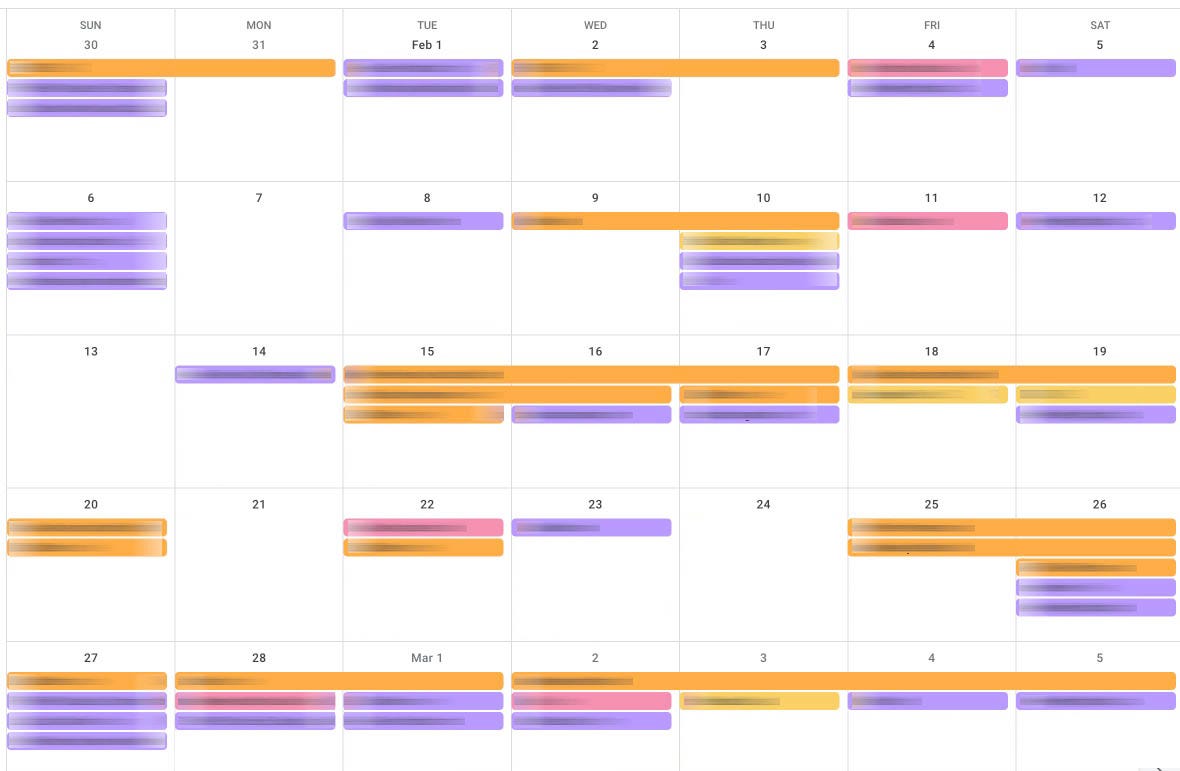
I turned off my regular appointments so you can see how I block out chunks of time. This is a busy month.
I start with Project Due. Each deadline is placed on the calendar in a full-day appointment. Those deadlines are displayed in red, so I can’t miss them. These calendar items represent the day I need to turn in a deliverable of one kind or another.
Next is DG Planner. I use this to block out a set of days for everything that has a Project Due entry. If a project will take me four days, I use four full-day appointments. If three days, I use three, and so on. This way, I can see how busy I’ll get, and I can make sure I don’t double or triple-book any of my busiest production times.
Finally, there’s Planner Tentative. This is where I block out the approximate time a project I may or may not be working on will probably take. That way, if I’m taking with my team about a bunch of projects, I can block out some tentative time and see how my month is shaping up.
With this system, I rarely lose track of projects and also rarely overbook myself. It’s worked quite well for a bunch of years now.
Rethinking your flow
Every few years, I rethink my productivity flow, usually when I find myself getting too far behind, or getting that baaaad feeling that I’m letting things slip through the cracks. This latest optimization, where I added Notion, has been working for a few months now, and so far it’s the most effective flow I’ve used. Most of the elements, particularly how I use Gmail and Pocket, have been productive processes for years.
As I mentioned earlier, your flow will be different, but I strongly recommend you think about your work processes and optimize your daily activities. You’ll find you’re more effective and also that your days are more pleasant.
That’s pretty much a nice win-win, isn’t it?
P.S. Surprisingly enough, there’s no Microsoft software in my daily tools, still. Used to be, I lived in Outlook. I still use PowerPoint heavily for presentations, but my daily productivity is now completely non-Microsoft. That wasn’t a political decision or statement. I rather like Microsoft. I just looked for and found the best tools for doing my job. If I were at Microsoft, I’d think long and hard about that.
You can follow my day-to-day project updates on social media. Be sure to follow me on Twitter at @DavidGewirtz, on Facebook at Facebook.com/DavidGewirtz, on Instagram at Instagram.com/DavidGewirtz, and on YouTube at YouTube.com/DavidGewirtzTV.
Stay connected with us on social media platform for instant update click here to join our Twitter, & Facebook
We are now on Telegram. Click here to join our channel (@TechiUpdate) and stay updated with the latest Technology headlines.
For all the latest Technology News Click Here
For the latest news and updates, follow us on Google News.



